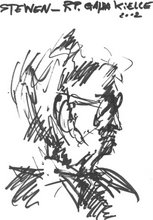Kabanos is in the news today, which started me thinking about writing something on my difficulty in knowing if I will like the ones on the supermarket shelf - sometimes excellent, but usually not. It was due to say something about them being "pork, fowl or just foul tasting" - salmon kabanosy are rather disappointing too - and the extent to which they are dry and/or smoked or not. I wasn't sure whether smoking was a standard feature, however, so I looked on Polish Wikipedia. However, this seemed to be incorrect and surprisingly short. I figured it was just my ignorance, but then I noticed that it was updated yesterday at the time when there are arguments about the Polish origin of Kabanosy. So I looked at the English version to see what it said: the difference was so extreme that I then looked at other languages (with the help of Google Translate).
The background is the attempt to make Kabanosy an EU registered Polish product, which helps protect producers from competition. I now strongly suspect that several Wikipedia versions, including Polish, have been rewritten in line with this application, omitting anything that might conflict with it. Google Translate gives the Polish version to be:
Kabanos - thin, long sausage, prepared with cured pork , carefully dried and smoked. The name comes from the Turkish word Kaban (commonly used also in the region of Białystok ), a hog.
Poles seek applicants for a determination Traditional Speciality Guaranteed for Kabanos.
Only pork? "Carefully dried and smoked"? Pull the other one ...
The English and Italian versions were last amended in April and are virtually identical to each other. The former is:
Kabanos (plural: kabanosy), also known as Kabana in Australia is an Eastern European sausage made of pork. They are most commonly dry to very dry in texture and smoky in flavour. Typically they are quite long - 30-60 cm (12-24 in) but very thin, with a diameter of around 2 centimetres (0.79 in), giving them a very characteristic appearance.
The name comes from the Turkish term (later on also used in Ukraine and some parts of Eastern Europe) "kaban", which means hog (male pig). A similar product is known as cabanossi elsewhere in Europe.
Kabanos is often seasoned only with pepper. Currently, kabanos (the type sold in many delis) is made of pork. Up until recently kabanos was made of different meats, including horse, beef and lamb. Although these kabanos variants can be found in rural parts of Poland, the majority of kabanos remain a pork product. Kabanos, unlike other meats such as sausage, are typically eaten alone as an appetizer, and often served with cheese.
Versions made of turkey are a staple in kosher meat markets and delicatessens.
Kabanos are commonly used as hiking food because they do not spoil as quickly as many other sausages.
The German version was also updated this month and has kabanos as a solely Polish product, but is more informative than the Polish version. The Germans oppose the Polish traditional product proposal as they also claim it as one of their sausages, but there is no reference to a German product. A reference to Pan Tadeusz suggests a Polish source. It is difficult not to suspect judicious editing here too.
Kabanos (plural: Kabanosy) is the name of a traditional Polish sausage , from the marinated pork and prepared hot smoked is. A Kabanos is relatively thin and usually has a length of about 70-80 cm. For smoking it is in the middle hanging on a pole, so there are two approximately 35-40 cm long sections with adjacent ends which are connected by an arch.
The meat for Kabanosy is from specially fattened Polish pigs. Kabanosy stand out among others by their brittleness at the same time, relatively high fat content. In its current form, the sausages were in the 1920s in Poland developed. In the EU request, is to register as a TSG before.
The name "Kabanosy" refers to the much older, in northeastern Poland and Lithuania expressed kaban use for mainly with potatoes fattened pig, which is particularly lean meat mixed. The term is also found in Adam Mickiewicz - such as in Pan Tadeusz (1834) - and is probably South East origin.
You can check the Israeli and Swedish versions for yourselves.
The English version much more reflects reality in Polish shops, but may need updating if the EU decides that it is a Polish traditional product made of pork. If that happens, it will also be interesting to see if the Polish authorities start legal proceedings against the Polish kabanosy producers who will not then be making kabanosy. Getting them "carefully dried and smoked" will presumably be beyond anyone's powers though.
Tuesday 31 August 2010
Monday 30 August 2010
Polish Building Sites in Bloom
At the end of July, the colour of the season was white. The local pair of white storks can just be seen in the top right hand corner of the photo.
Perhaps it doesn't look like a building site, but the ground is part of the Belina Estate in Młochów (see www.belina.pl). However, building has been in abeyance after completion of the first phase of development at the end of 2008, just in time to miss the housing boom and get caught by its collapse. Houses can be seen below.
 .
.
Last year, the earth from building work piled to the left were more obvious and host to a bright display of red poppies.
To be honest, the colour of the season over the last few days has been closer to grey, but when the sun shone earlier last week it was glorious yellow.
I think the predominant flower is called goldenrod, but I could be quite wrong. There are other yellow flowers in abundance, though.

These pictures were taken when walking down Middle Road (ul. Środkowa) in Rusieć, pronounced Rooshets. Calling this a 'building site' is a slight exaggeration, although it all seems to be land ready and waiting for private house building. There are already a scattering of houses built and in the process of being built. Some are visible below.
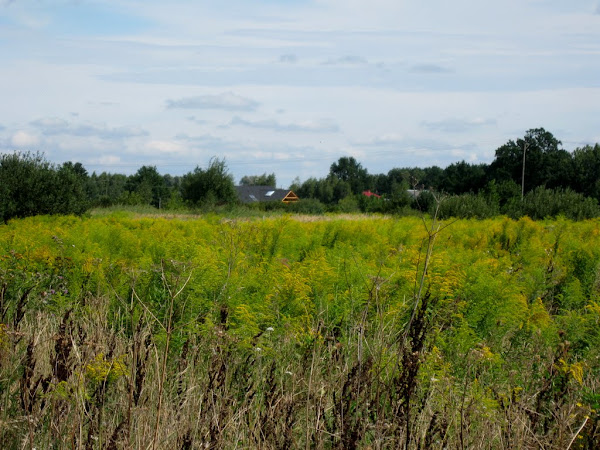
| From 2010 07 |
Perhaps it doesn't look like a building site, but the ground is part of the Belina Estate in Młochów (see www.belina.pl). However, building has been in abeyance after completion of the first phase of development at the end of 2008, just in time to miss the housing boom and get caught by its collapse. Houses can be seen below.
Last year, the earth from building work piled to the left were more obvious and host to a bright display of red poppies.
| From 2009 06 Mlochow |
To be honest, the colour of the season over the last few days has been closer to grey, but when the sun shone earlier last week it was glorious yellow.
| From 2010 08 |
I think the predominant flower is called goldenrod, but I could be quite wrong. There are other yellow flowers in abundance, though.
These pictures were taken when walking down Middle Road (ul. Środkowa) in Rusieć, pronounced Rooshets. Calling this a 'building site' is a slight exaggeration, although it all seems to be land ready and waiting for private house building. There are already a scattering of houses built and in the process of being built. Some are visible below.
Sunday 29 August 2010
Smolensk Plane Crash Fiasco
I don't want to get involved in political comment: I have never had the sympathy or understanding to be able to decide on other people's heartfelt responses. However, strong elements of farce are starting to emerge.
I don't trust opinion polls. They are often wrong for a very wide range of reasons, not least respondent unreliability and the difficulty of getting simple unbiased questions. This is made worse by what we see in the news. The polling company produces a press notice and summary designed to be interesting: they want clients to pay for the company's output. The press notice is then edited by journalists, if only for space reasons, who exaggerate the interest element, whilst often failing to understand what the results mean and with no idea how to present it. Finally headline writers come in with the task of making the whole item worth reading or listening to.
thenews.pl - smolensk-cross -the president should decide is an example of this. The headline says the Polish president should decide/have the final say (70% of people polled), with this as the headline and put in bold in the first paragraph. The following text has about 67% for the Warsaw President, 55% for the families and 53% for the church. Since this gives us 247% of pollsters' having an opinion, it is clear that something has gone wrong.
My guess is that individual people polled have chosen several options out of a list they are given in the poll. The question may well have been about which one should make the final choice, but the result shows clearly that there should not be one person, but there should be a representative group ie that the Polish President, etc should not be allowed to decide on his own. The article should really about who should be represented in the group deciding on the fate of the cross. I don't know whether it was the polling company or the journalists who did not expect this or who simply did not think it interesting enough. However, competent journalism should tell us this, rather than leaving us to figure out what they are talking about. The headline is one of those that completely fails to tell the truth, whilst not telling a single lie: the sign of a great headline writer, but the article creates it in this case.
Those of you used to translations of Polish into English might have expected me to add the incompetence of translation into the list of reasons for resulting inanities. However, thenews.pl is exceptional in normally having excellent English. The author of the English version has his initials at the bottom so you can trace the competent translators. Although I only looked when a short period of low competence - holidays? - was followed by good English, I think it was pg who particularly impressed me:, indeed, sufficient to wonder if he was English.
I don't trust opinion polls. They are often wrong for a very wide range of reasons, not least respondent unreliability and the difficulty of getting simple unbiased questions. This is made worse by what we see in the news. The polling company produces a press notice and summary designed to be interesting: they want clients to pay for the company's output. The press notice is then edited by journalists, if only for space reasons, who exaggerate the interest element, whilst often failing to understand what the results mean and with no idea how to present it. Finally headline writers come in with the task of making the whole item worth reading or listening to.
thenews.pl - smolensk-cross -the president should decide is an example of this. The headline says the Polish president should decide/have the final say (70% of people polled), with this as the headline and put in bold in the first paragraph. The following text has about 67% for the Warsaw President, 55% for the families and 53% for the church. Since this gives us 247% of pollsters' having an opinion, it is clear that something has gone wrong.
My guess is that individual people polled have chosen several options out of a list they are given in the poll. The question may well have been about which one should make the final choice, but the result shows clearly that there should not be one person, but there should be a representative group ie that the Polish President, etc should not be allowed to decide on his own. The article should really about who should be represented in the group deciding on the fate of the cross. I don't know whether it was the polling company or the journalists who did not expect this or who simply did not think it interesting enough. However, competent journalism should tell us this, rather than leaving us to figure out what they are talking about. The headline is one of those that completely fails to tell the truth, whilst not telling a single lie: the sign of a great headline writer, but the article creates it in this case.
Those of you used to translations of Polish into English might have expected me to add the incompetence of translation into the list of reasons for resulting inanities. However, thenews.pl is exceptional in normally having excellent English. The author of the English version has his initials at the bottom so you can trace the competent translators. Although I only looked when a short period of low competence - holidays? - was followed by good English, I think it was pg who particularly impressed me:, indeed, sufficient to wonder if he was English.
Wednesday 25 August 2010
Driving in Poland
There are a couple of items on improving road safety in Poland on www.thenews.pl this morning. One is a about a blitz to improve the quality of roads over the next couple of years. There are some dreadful roads, but more amazing to me is the extreme rapidity with which road improvements are already taking place. When driving on roads in Poland that have been transformed beyond recognition from just a couple of years ago, I remember the years and years it took to build wide enough roads between London and Norfolk to deal with the traffic, and still not covering the entire route to Norwich and the north coast.
The second item covers concern that local councils are using road cameras to maximise income rather than to maximise safety. My own impression is that speed cameras on local roads are much better placed than on the national road system; perhaps this is just the nature of the local councils in the areas I tend to drive. Speed limit signage is roughly equally awful.
The extreme speed of Polish driving is a routine matter for comment. Following an item on W-wa Jeziorki, I tried to get an impression of Polish speed compared to Czech, Austria and Italy - the latter including quite a bit of urban driving. Trying to drive at the speed limit, I am normally one of the slowest on the road in Poland, but I was one of the fastest on the road in the other countries. This was especially clear in areas with low speed limits. I was very disappointed to find that the legendary appalling driving of Italians was nowhere to be seen. I think the difference is that people in these countries drive with full consciousness of the speed that they should be driving at, even if they decide to ignore it. In Poland, people drive at the speed they consider themselves to be appropriate for the conditions with no concern for what the authorities have decided is right - speed cameras are an obstruction, irrelevant to safety.
Having done all the speeding bit for years, I decided for various reasons some years ago to drive within the speed limit. I found this extraordinarily difficult in terms of getting the general feeling that I wasn't driving absurdly slow. However, I wasn't always sure what the speed limit was and people in the car with me never seemed to know either. Having driven across the border, I noticed the standard border speed notice by the road and was surprised to see that the daytime speed limit in built up areas was 50 kph, not 60 kph. I was so surprised that I doubted what I saw and checked with the regulars in a local bar. This resulted in a very heated argument around me, with one stubborn customer being assailed and insulted from all sides for daring to argue that I was right. He and I were right - it is 50, but just try doing it. Despite regular efforts to achieve this, I keep going back to 60. Even this has a queue of frustrated drivers behind me on single lane roads - I try to let them pass when I can, whilst on Warsaw's large 3 lane roads, I get the feeling that bicycles could pass me by - buses sometimes do.
From thenews.pl's article, it seems clear that the government is not trying to encourage driving at safe speeds generally, but just wishes to reduce the worst effects of this at the worse places. I wonder whether this is the right approach.
The second item covers concern that local councils are using road cameras to maximise income rather than to maximise safety. My own impression is that speed cameras on local roads are much better placed than on the national road system; perhaps this is just the nature of the local councils in the areas I tend to drive. Speed limit signage is roughly equally awful.
The extreme speed of Polish driving is a routine matter for comment. Following an item on W-wa Jeziorki, I tried to get an impression of Polish speed compared to Czech, Austria and Italy - the latter including quite a bit of urban driving. Trying to drive at the speed limit, I am normally one of the slowest on the road in Poland, but I was one of the fastest on the road in the other countries. This was especially clear in areas with low speed limits. I was very disappointed to find that the legendary appalling driving of Italians was nowhere to be seen. I think the difference is that people in these countries drive with full consciousness of the speed that they should be driving at, even if they decide to ignore it. In Poland, people drive at the speed they consider themselves to be appropriate for the conditions with no concern for what the authorities have decided is right - speed cameras are an obstruction, irrelevant to safety.
Having done all the speeding bit for years, I decided for various reasons some years ago to drive within the speed limit. I found this extraordinarily difficult in terms of getting the general feeling that I wasn't driving absurdly slow. However, I wasn't always sure what the speed limit was and people in the car with me never seemed to know either. Having driven across the border, I noticed the standard border speed notice by the road and was surprised to see that the daytime speed limit in built up areas was 50 kph, not 60 kph. I was so surprised that I doubted what I saw and checked with the regulars in a local bar. This resulted in a very heated argument around me, with one stubborn customer being assailed and insulted from all sides for daring to argue that I was right. He and I were right - it is 50, but just try doing it. Despite regular efforts to achieve this, I keep going back to 60. Even this has a queue of frustrated drivers behind me on single lane roads - I try to let them pass when I can, whilst on Warsaw's large 3 lane roads, I get the feeling that bicycles could pass me by - buses sometimes do.
From thenews.pl's article, it seems clear that the government is not trying to encourage driving at safe speeds generally, but just wishes to reduce the worst effects of this at the worse places. I wonder whether this is the right approach.
Monday 23 August 2010
Christmas Lights in August
We went to my sister-in-law, Ilona's flat on Saturday for her Name Day celebration. She lives on one of the Warsaw tower block estates in Gocławek (Gots-wa-vek) on the east bank of the Vistula. Standing on the balcony in the dark, I was rather taken by the focused concentrations of lights from the flats and streets against the ambient dark and light contrasts of sky, shadows and buildings.
The photos do not do it justice - my little snapshot camera does not have an effective night setting, but you can get a rough idea from them. A view to the left:
And to the right:
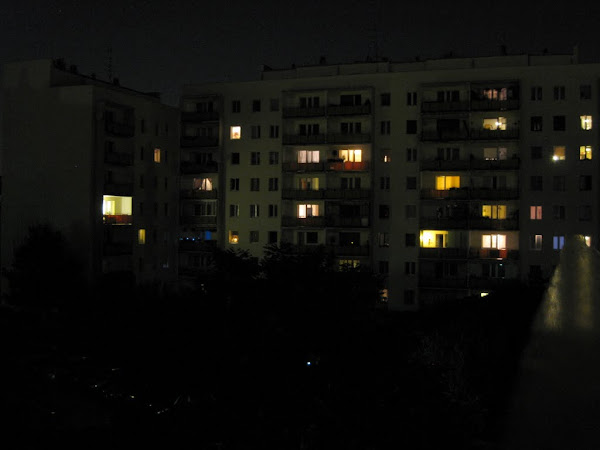
The overall charm of the peace and calm, leaning on the balcony on a quiet Warsaw Saturday evening, was something worth simply standing there and absorbing. The sound of distant explosions enhancing the sense of relaxation. Then Babcia (Grandma - my mother-in-law) came out and said "shooting" and started to get worried. It was just a firework display, though, out of sight.
The photos do not do it justice - my little snapshot camera does not have an effective night setting, but you can get a rough idea from them. A view to the left:
| From 2010 08 |
And to the right:
The overall charm of the peace and calm, leaning on the balcony on a quiet Warsaw Saturday evening, was something worth simply standing there and absorbing. The sound of distant explosions enhancing the sense of relaxation. Then Babcia (Grandma - my mother-in-law) came out and said "shooting" and started to get worried. It was just a firework display, though, out of sight.
Saturday 21 August 2010
It's August - It's Autumn
What do I know? From city life in London, August was high summer. A couple of years in the Polish countryside and I am beginning to have my doubts. Last year the early days of the month had beautiful misty mornings - archetypal autumnal weather, but, I thought, it was a very wet year so this was just an oddity.
By the middle of August this year, leaves on the trees were starting to change colour and shed. Perhaps this was just young trees in an unsheltered position.


The grassland is going brown, but that is quite normal in a hot dry summer, although this one was wet and hot.

The trees in the background all seem to be green, but when we went down Chestnut Avenue (Aleja Kasztanowa) there is quite significant browning of the trees when looked at from the road. Driving into Warsaw later, this was even more evident in a number of places along the road.
Mind you, house martins have returned, although in limited numbers and with different behaviour patterns. Perhaps they are from further north and stopping here for a rest.
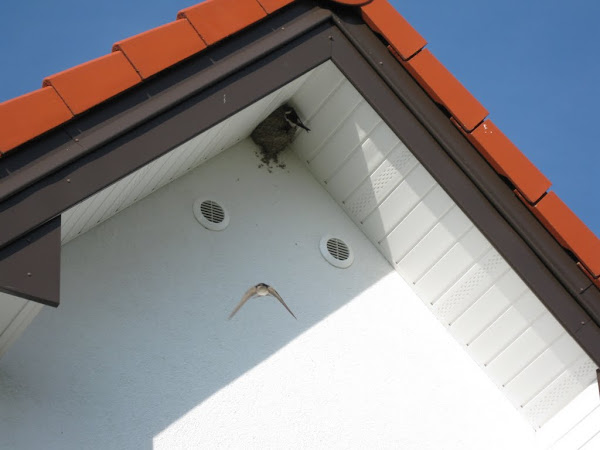
By the middle of August this year, leaves on the trees were starting to change colour and shed. Perhaps this was just young trees in an unsheltered position.
| From 2010 08 |
The grassland is going brown, but that is quite normal in a hot dry summer, although this one was wet and hot.
The trees in the background all seem to be green, but when we went down Chestnut Avenue (Aleja Kasztanowa) there is quite significant browning of the trees when looked at from the road. Driving into Warsaw later, this was even more evident in a number of places along the road.
Mind you, house martins have returned, although in limited numbers and with different behaviour patterns. Perhaps they are from further north and stopping here for a rest.
Thursday 19 August 2010
Polish Tourist Sites Made Easy
In Dębki, I found a wonderful English language tourist guide that can make touring around the Polish countryside a much simpler tourist experience. Its actually an atlas, with tourist sites highlighted and described. It is called Polish Highways and Byways.
The format (A4 size) is a single left hand page local area map, followed by a right hand page (sometimes more) of information that includes standard historic buildings, but with wider interesting titbits about, and pictures of, key places. Whether you are staying/living somewhere or touring around, it provides a very easy way to see where you can go or stop and have a look.
The cost in the Dębki discount book marquee (one of three there) was 20zl, so have a look in your local cheap book shops. It is still advertised by Empik on the internet at 39 zl (and on a US site at 30 dollars). Polish, German and Russian versions are also available.
As an example local to me, take Raszyn, which lies next to Warsaw on the Krakow Road, inseparable from the Warsaw urban sprawl apart from road signs. I now know it has a baroque and classicist parish church (1654, rebuilt in 1790) and a classicist former inn and stables (18th Century). I also found that it is the largest village in Poland, which was a surprise; that it was the site of a battle in 1809, and that Raszyn Ponds is a nature reserve nearby. To be honest, none of this would get me excited enough to stop and visit, especially as Raszyn Ponds are clearly visible from the main road, as are the lack of easy parking places next to it. The 1809 battle might well have got me looking on the internet if I hadn't heard of it before. So all in all, even this apparently non-visiting place is given a bit more colour. Wikipedia English adds a bit more (and the Polish a little more than that).
However, none of these, and maybe no English language site, tells you that part of the Polish defensive redoubt is still there with a small commemorative plaque. It's a small patch of green between buildings on the side of the road leaving Warsaw by the traffic light junction with ul. Sportowa (Sport Street). Although not a magnificent site on its own, It might be interesting for people interested in major Polish battles. I only found it walking down Krakowska from the tram/bus terminal at Okęcie, along the bus route to Młochów. It was a hot day and a cold beer in a nice pub would have gone down well. Silly me, although I did eventually come across an acceptable (because of the barmaid), but empty combined pizza restaurant and sports TV pub. Actually, my advice to anyone thinking of doing the same thing is to find the Redoubt, then go to one of the nearby shops, buy a beer from the fridge and go and sit on the mound and drink it there.
| From 2010 08 |
The format (A4 size) is a single left hand page local area map, followed by a right hand page (sometimes more) of information that includes standard historic buildings, but with wider interesting titbits about, and pictures of, key places. Whether you are staying/living somewhere or touring around, it provides a very easy way to see where you can go or stop and have a look.
The cost in the Dębki discount book marquee (one of three there) was 20zl, so have a look in your local cheap book shops. It is still advertised by Empik on the internet at 39 zl (and on a US site at 30 dollars). Polish, German and Russian versions are also available.
As an example local to me, take Raszyn, which lies next to Warsaw on the Krakow Road, inseparable from the Warsaw urban sprawl apart from road signs. I now know it has a baroque and classicist parish church (1654, rebuilt in 1790) and a classicist former inn and stables (18th Century). I also found that it is the largest village in Poland, which was a surprise; that it was the site of a battle in 1809, and that Raszyn Ponds is a nature reserve nearby. To be honest, none of this would get me excited enough to stop and visit, especially as Raszyn Ponds are clearly visible from the main road, as are the lack of easy parking places next to it. The 1809 battle might well have got me looking on the internet if I hadn't heard of it before. So all in all, even this apparently non-visiting place is given a bit more colour. Wikipedia English adds a bit more (and the Polish a little more than that).
However, none of these, and maybe no English language site, tells you that part of the Polish defensive redoubt is still there with a small commemorative plaque. It's a small patch of green between buildings on the side of the road leaving Warsaw by the traffic light junction with ul. Sportowa (Sport Street). Although not a magnificent site on its own, It might be interesting for people interested in major Polish battles. I only found it walking down Krakowska from the tram/bus terminal at Okęcie, along the bus route to Młochów. It was a hot day and a cold beer in a nice pub would have gone down well. Silly me, although I did eventually come across an acceptable (because of the barmaid), but empty combined pizza restaurant and sports TV pub. Actually, my advice to anyone thinking of doing the same thing is to find the Redoubt, then go to one of the nearby shops, buy a beer from the fridge and go and sit on the mound and drink it there.
Tuesday 17 August 2010
The Polish Seaside
I had my third trip to the Polish seaside this year. My very first had me lauding the cleanliness of the water and beaches, much to the ridicule of Basia, my wife, who knew from Polish television that it was dirty and polluted. This year, international reality had had its effect, with the purity of Polish water being unmistakeable when compared to Italian filth on the Adriatic coast just north of Ravenna a few weeks earlier. It was her turn this year to let me know how clean it was in Poland. I particularly like seeing fish swimming just near the beach.
The brown water of a river flowing into the sea was colouring, not dirt.
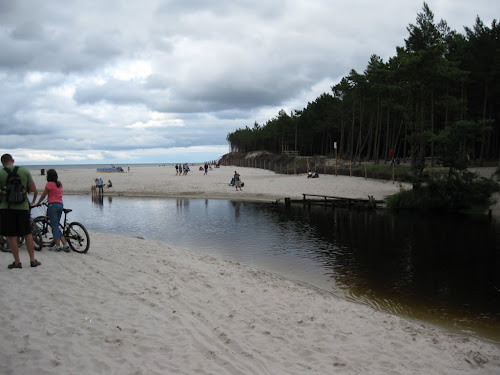

Access to the beach from the town was through a stretch of woodland.

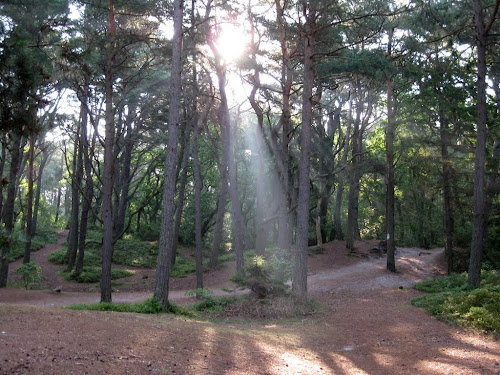
The beach was wide and made up of clean, fine white sand.
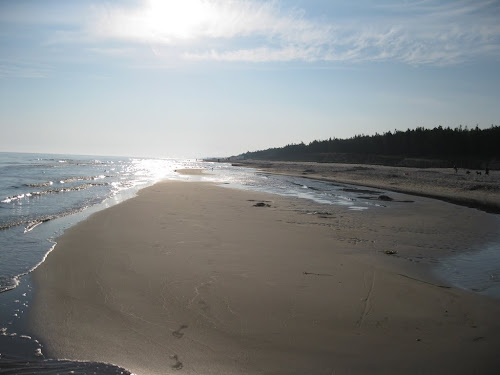
Misia, our daughter, loved the waves. The flat Italian sea had been boring.

There were enough people to make the sand closest to the sea busy, rather than jammed, whilst closer to the wood and away from the main town access paths, there was plenty of empty space.

The bar sold plenty of drinks and snacks, although surprisingly little food. People walked the few minutes back to town or took sandwiches. Beer here and in town was 6zl a half litre. The bar also hosted the town's once a week club music event.

There was one beach entertainment for youngsters in addition to the sea and sand: 10zl for 10 minutes.
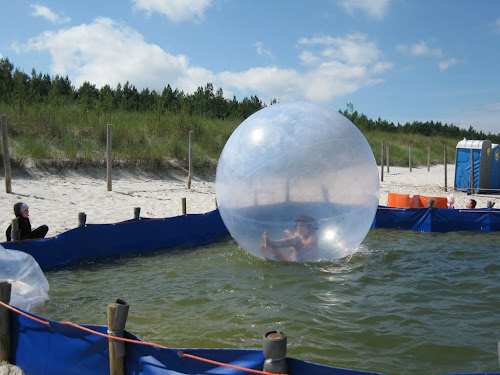
Canoeing for others.
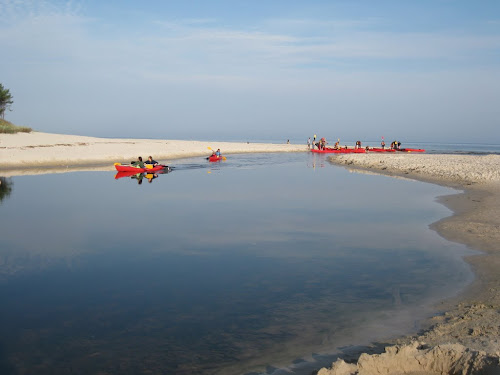
The weather was wonderfully cool compared to the heat of Warsaw. There was quite a bit of cloud, but virtually no rain over the week.

The town of Dębki seems almost completely dedicated to its tourists, with little sign of general residence. Accommodation ranged from houses to rent, through bed and breakfast to space for tents. We had a chalet with communal toilets and wash facilities. I was the only one pleased that there wasn't a TV.
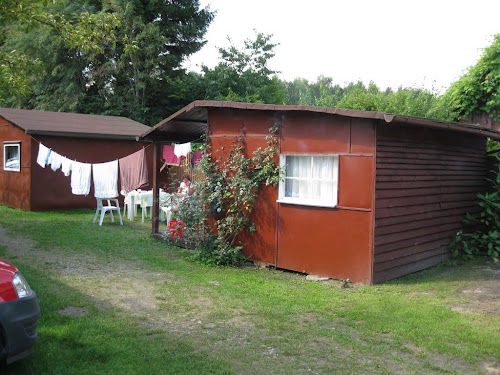
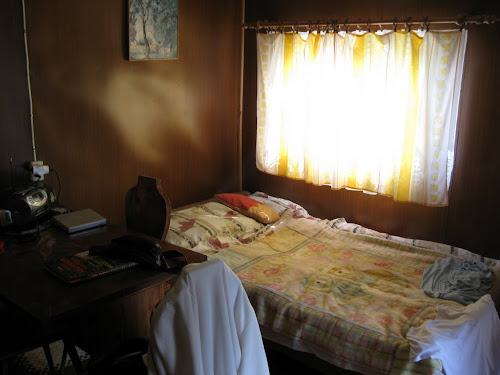
The visitors to Dębki largely seem to be families with young children. Although it was full of people, the shops were largely closed by 8.00 in the evening, with the bars/restaurants seeming to fade out by 10:00pm. Musical excitement was provided by a bar that had a one-man, keyboard band: something that I hate at New Year Celebrations, but which seemed completely natural here. Oh, and thinking of bars, I tried a local beer called Viva Hel, which turned out to be a nice Polish unpasteurised wheat-beer (weissbier) at the normal 6zl beer price. Unfortunately, the town seemed to have sold out a couple of days later when I went for a second (and third) bottle as a last evening, farewell drink.

| From 2010 08 Debki |
The brown water of a river flowing into the sea was colouring, not dirt.
Access to the beach from the town was through a stretch of woodland.
The beach was wide and made up of clean, fine white sand.
Misia, our daughter, loved the waves. The flat Italian sea had been boring.
There were enough people to make the sand closest to the sea busy, rather than jammed, whilst closer to the wood and away from the main town access paths, there was plenty of empty space.
The bar sold plenty of drinks and snacks, although surprisingly little food. People walked the few minutes back to town or took sandwiches. Beer here and in town was 6zl a half litre. The bar also hosted the town's once a week club music event.
There was one beach entertainment for youngsters in addition to the sea and sand: 10zl for 10 minutes.
Canoeing for others.
The weather was wonderfully cool compared to the heat of Warsaw. There was quite a bit of cloud, but virtually no rain over the week.
The town of Dębki seems almost completely dedicated to its tourists, with little sign of general residence. Accommodation ranged from houses to rent, through bed and breakfast to space for tents. We had a chalet with communal toilets and wash facilities. I was the only one pleased that there wasn't a TV.
The visitors to Dębki largely seem to be families with young children. Although it was full of people, the shops were largely closed by 8.00 in the evening, with the bars/restaurants seeming to fade out by 10:00pm. Musical excitement was provided by a bar that had a one-man, keyboard band: something that I hate at New Year Celebrations, but which seemed completely natural here. Oh, and thinking of bars, I tried a local beer called Viva Hel, which turned out to be a nice Polish unpasteurised wheat-beer (weissbier) at the normal 6zl beer price. Unfortunately, the town seemed to have sold out a couple of days later when I went for a second (and third) bottle as a last evening, farewell drink.
Monday 16 August 2010
Polish-Soviet War Commemoration
Polish victory in the Polish-Soviet War in 1920 was commemorated yesterday. This year it fell on the same day as a religious festival public holiday, so the shops were closed, but it is normally just part of the State calender of commemorative days. Even so, it is formally Polish Army Day rather than specific celebration of the victory. In a calender which has failed uprisings and an unimplemented constitution, I can't help think that a Polish success public holiday could useful replace a Polish failure.
It has often been said that you cannot understand a country unless you know it's history. My own take on this, which I haven't heard, but assume is a widespread view, is that you cannot understand the people of a country unless you know their perspective of their history. This is very true of Poland, where the people's perspective is fundamental in defining their country, society and their position in the world. The emotional weight that people I know give to long-past events are, from my London point of view, strangely disproportionate to their real current relevance. That people's knowledge of the events is often extremely limited and regularly distorted, but yet solid and unquestionable simply adds to the barriers of understanding. I have been harangued for over an hour twice for questioning the orthodox view of centuries old events, which I take to be the price a foreigner has to pay for being unable to mould a conversation to deal with the sympathies of people around me.
The Polish-Soviet war is of major emotional importance. See Jeziorki blog and polishmeknob blog for Polish perspectives. Whether the victory at the Battle of Warsaw was "One of the crucial battles of world history" is something I cannot even try to judge. That it is a forgotten war, is something I can agree with, but to be fair to my general knowledge - it was too recent an event to be part of my history education - it was just one of many conflicts in the area after World War I. That I was unaware of any details of these is a failure, but I would apply this equally to the Polish Ukrainian War, etc. These are forgotten wars.
However, I do think that the Polish Soviet War is of special importance in analysing the overall flow of 20th Century history. I can best describe this as an uninformed theory, but it seems to have some sense. Nationalism, imperialism and economic competition are standard themes for historical analysis. The social pressures of emancipation of the labouring classes and increasing democratisation can be added to the mix, but it was the excitement of communist ideology that really brought these to the fore as the dream of a new period of historical development, adding internationalism - the unity of peoples through consent.
It was in Poland at this time that the opposing pressures came to the test and ultimately set the pattern for the future. To many of the Bolsheviks, Poland must have seemed an inevitable convert. Piłsudski, the Polish leader, and many of his supporters were known to be communist. The Bolshevik revolutionaries included Polish enthusiasts. However, when it came to the test, it was nationalism that won with Piłsudski dreaming of a new Polish lead Commonwealth, which some of its subsidiary peoples (eg some Ukrainians) considered a proposed new Polish Empire. The Polish ruling elite from the past took its place in governing the country similar to its neighbours to the west.
It is my hypothesis that it was not just the Polish victory in battle that stopped the Soviet advanced, but that it defined the limit to which the new ideologies could defeat the old. It is from these ideological differences that the 'independent' Poland failed to be merged into the USSR and that Poland's Solidarity movement played its part if the end of Communism.
I recognise that my reference to Poland's independence will be considered by many (Poles in particular) to ignore the complete Russian domination that I am routinely told about. I suspect, however, that the completeness of this is part of contemporary Polish nationalist psychology. The routine implication that the many leaders and officials were vaguely sub-human, not-really-Polish people even though by any normal standards they were, seems to be more perspective than objective. (The position of the second nation - Jews - is a separate issue.)
I have no idea whether these trends have any relevance today beyond Poland's view of itself. Current Lithuanian, Belarusian and Ukrainian suspicions of Poland may as much be viewed as counter to my hypothesis as to support it. However, for anyone wanting to get a new perspective on 20th Century history, I would like to think that these principles might help focus on principles too look at. Would a European history exam question in England - "The spread of Communist development was limited by ideological pressure rather than political alliance. Consider this concept in the light of the Polish Soviet War" - be a good hook for gaining interest in Central European history?
It has often been said that you cannot understand a country unless you know it's history. My own take on this, which I haven't heard, but assume is a widespread view, is that you cannot understand the people of a country unless you know their perspective of their history. This is very true of Poland, where the people's perspective is fundamental in defining their country, society and their position in the world. The emotional weight that people I know give to long-past events are, from my London point of view, strangely disproportionate to their real current relevance. That people's knowledge of the events is often extremely limited and regularly distorted, but yet solid and unquestionable simply adds to the barriers of understanding. I have been harangued for over an hour twice for questioning the orthodox view of centuries old events, which I take to be the price a foreigner has to pay for being unable to mould a conversation to deal with the sympathies of people around me.
The Polish-Soviet war is of major emotional importance. See Jeziorki blog and polishmeknob blog for Polish perspectives. Whether the victory at the Battle of Warsaw was "One of the crucial battles of world history" is something I cannot even try to judge. That it is a forgotten war, is something I can agree with, but to be fair to my general knowledge - it was too recent an event to be part of my history education - it was just one of many conflicts in the area after World War I. That I was unaware of any details of these is a failure, but I would apply this equally to the Polish Ukrainian War, etc. These are forgotten wars.
However, I do think that the Polish Soviet War is of special importance in analysing the overall flow of 20th Century history. I can best describe this as an uninformed theory, but it seems to have some sense. Nationalism, imperialism and economic competition are standard themes for historical analysis. The social pressures of emancipation of the labouring classes and increasing democratisation can be added to the mix, but it was the excitement of communist ideology that really brought these to the fore as the dream of a new period of historical development, adding internationalism - the unity of peoples through consent.
It was in Poland at this time that the opposing pressures came to the test and ultimately set the pattern for the future. To many of the Bolsheviks, Poland must have seemed an inevitable convert. Piłsudski, the Polish leader, and many of his supporters were known to be communist. The Bolshevik revolutionaries included Polish enthusiasts. However, when it came to the test, it was nationalism that won with Piłsudski dreaming of a new Polish lead Commonwealth, which some of its subsidiary peoples (eg some Ukrainians) considered a proposed new Polish Empire. The Polish ruling elite from the past took its place in governing the country similar to its neighbours to the west.
It is my hypothesis that it was not just the Polish victory in battle that stopped the Soviet advanced, but that it defined the limit to which the new ideologies could defeat the old. It is from these ideological differences that the 'independent' Poland failed to be merged into the USSR and that Poland's Solidarity movement played its part if the end of Communism.
I recognise that my reference to Poland's independence will be considered by many (Poles in particular) to ignore the complete Russian domination that I am routinely told about. I suspect, however, that the completeness of this is part of contemporary Polish nationalist psychology. The routine implication that the many leaders and officials were vaguely sub-human, not-really-Polish people even though by any normal standards they were, seems to be more perspective than objective. (The position of the second nation - Jews - is a separate issue.)
I have no idea whether these trends have any relevance today beyond Poland's view of itself. Current Lithuanian, Belarusian and Ukrainian suspicions of Poland may as much be viewed as counter to my hypothesis as to support it. However, for anyone wanting to get a new perspective on 20th Century history, I would like to think that these principles might help focus on principles too look at. Would a European history exam question in England - "The spread of Communist development was limited by ideological pressure rather than political alliance. Consider this concept in the light of the Polish Soviet War" - be a good hook for gaining interest in Central European history?
Sunday 15 August 2010
House Martins
The Martins arrived in May and soon got down to building their nests, picking up mud from the pools of water on the unmade road behind our house.
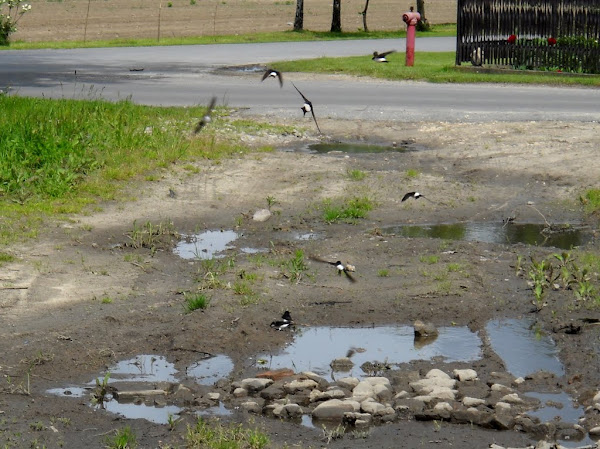

By the end of July, the young birds were practising their flying and landing on walls, ...

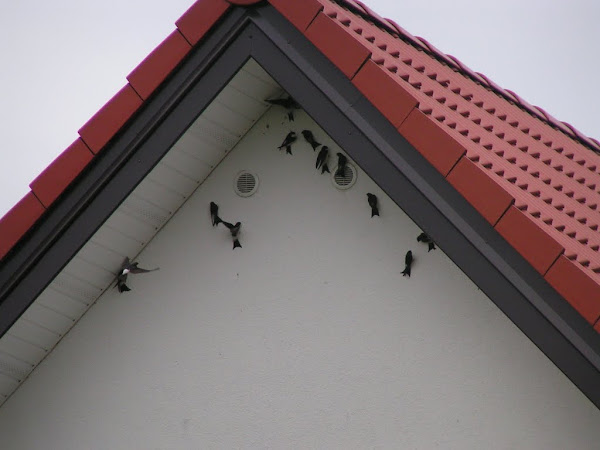
... taking time to rest on roofs.
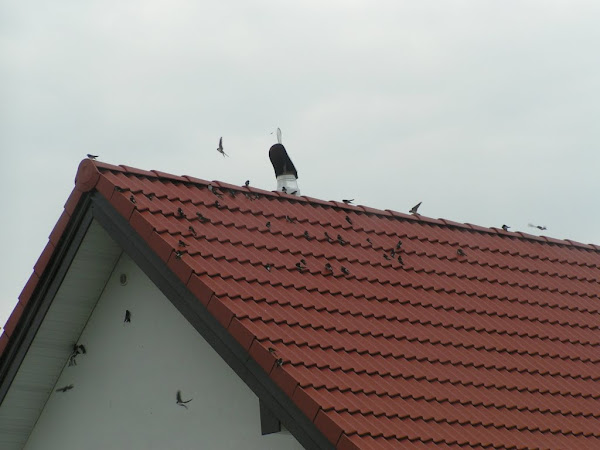
Most of the young birds had left their nests, which were now a refuge from the mid-day heat and home for the night.

Although one, of our three, still had young being fed.
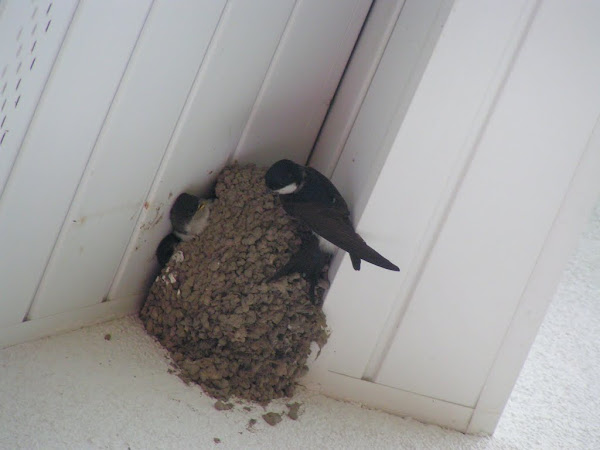
Returning from a trip away from home, in Mid-August, they had disappeared. Was it just a training flight or had they already started for their winter homes? Some have reappeared today.
By the end of July, the young birds were practising their flying and landing on walls, ...
... taking time to rest on roofs.
Most of the young birds had left their nests, which were now a refuge from the mid-day heat and home for the night.
Although one, of our three, still had young being fed.
Returning from a trip away from home, in Mid-August, they had disappeared. Was it just a training flight or had they already started for their winter homes? Some have reappeared today.
Subscribe to:
Posts (Atom)
